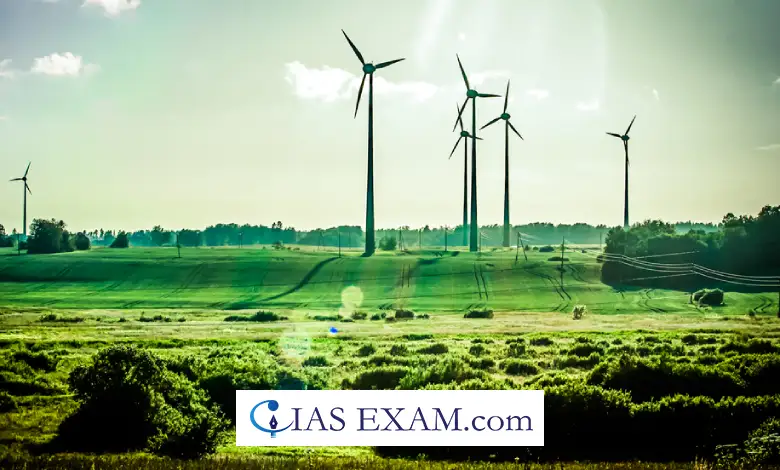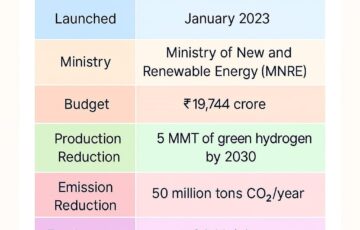India’s Energy Transition: Lessons from the Uk’s Coal Phase-out
Syllabus:
GS-2: Renewable Energy
GS-3:Government Policies & Interventions
Focus:
The UK’s closure of its last coal-fired power plant marks a significant milestone in energy transition, prompting discussions on the applicability of this model to India. As India aims for net-zero emissions by 2070, understanding successful strategies from the UK can inform its approach.
A Milestone in Energy Transition:
- The closure of the last coal-fired power plant in the UK represents a significant shift in global energy production.
- This transition has not been without challenges, contrary to the often positive media portrayals.
- Calls have emerged for other countries, especially developing ones, to follow the UK’s example in phasing out coal.
- While the UK’s model may work for developed nations, developing countries need customised strategies.
- The journey towards coal phase-out began long before the 2015 Paris Agreement, rooted in historical events like the Great Smog of 1952.
Understanding Energy Transition:
- Definition:
- The shift from high greenhouse gas-emitting energy sources (like fossil fuels) to low or zero-emission sources.
- Involves creating a sustainable energy mix that reduces carbon emissions.
India’s Renewable Energy Mix (May 2024):
- Composition:
- Solar: 57%
- Wind: 32%
- Biomass Cogeneration: 7%
- Small Hydro Power: 3%
- Waste to Energy: 1%
- Visual: Pie chart with distinct colour segments for each energy type and labelled percentages.
Significance of Energy Transition for India:
- Energy Security: Enhances energy independence and reduces reliance on imported fossil fuels.
- Job Creation: Generates employment opportunities in renewable energy sectors.
- Climate Goals: Supports efforts to achieve net-zero emissions by
India’s Status of Clean Energy Transition:
- Global Ranking:
- 4th in Renewable Energy Installed Capacity.
- 4th in Wind Power Capacity.
- 5th in Solar Power Capacity.
- Installed Capacity Growth:
- Increased from37 GW in 2014 to 193.58 GW (including hydro) by May 2024.
Renewable Energy Targets in India:
- 2030 Goals:
- Achieve a non-fossil fuel energy capacity of 500 GW.
Fulfil at least half of total energy requirements through
- renewable energy sources by 2030.
Major Government Initiatives Related to Renewable Energy Transition:
- Pradhan Mantri Sahaj Bijli Har Ghar Yojana (SAUBHAGYA):
- Aims to provide electricity access to all households in India.
- Focuses on the electrification of rural and underprivileged areas.
- Green Energy Corridor (GEC):
- Infrastructure project to facilitate the transmission of renewable energy.
- Enhances grid connectivity for solar and wind energy.
- National Smart Grid Mission (NSGM):
- Promotes the development of smart grid technology for efficient energy management.
- Supports the integration of renewable energy sources.
- Faster Adoption and Manufacturing of (Hybrid &) Electric Vehicles (FAME):
- Incentives for electric and hybrid vehicle adoption.
- Aims to reduce vehicular emissions and dependency on fossil fuels.
- International Solar Alliance (ISA):
- A coalition of countries to promote solar energy use and development.
Facilitates cooperation in solar
- technology and financing.
- Surya Ghar Muft Bijli Yojana:
- Provides solar power connections at no cost to eligible households.
Aims to enhance solar energy adoption in rural areas.
Historical Context of Coal in the UK:
- The Great Smog of London in 1952 catalysed environmental reforms, including the 1956 Clean Air Act.
- The transition involved multiple socio-political and economic factors over 70 years, not just a single agreement.
- The discovery of North Sea natural gas in 1965 reduced reliance on coal, which became economically viable due to rising costs.
- The closure of coal mines in the 1980s led to social and economic decline in former coal regions, highlighting the importance of careful planning.
- While the urgency to reduce carbon emissions is clear, India’s approach must consider its unique context and historical path.
India’s Carbon Emissions Landscape:
- India ranks as the third-largest carbon emitter, producing 9 gigatons in 2023, compared to the UK’s 384 million metric tonnes.
- With a population over 20 times that of the UK, India’s per capita emissions are notably lower at 2 tonnes, compared to the UK’s 5.5 tonnes.
- Historical emissions analysis shows the UK’s colonial past contributed significantly to its carbon footprint, totaling 10.4 billion tonnes since 1850.
- India has an extensive coal history, beginning with its first coal mine established in 1774 by the British East India Company.
- Current coal consumption is high, with about 70% of India’s energy output coming from coal, and projections indicate increasing demand until around 2030-2035.
Learning from the UK’s Transition:
- India has the opportunity to learn from the UK’s experience, avoiding past mistakes while adopting effective strategies.
- The UK has focused on retraining programs and regional redevelopment for communities reliant on coal.
- Early retirement plans, redundancy payments, and new education programs supported a smoother transition.
- Renewable energy projects, especially offshore wind farms, were strategically placed near coal-producing regions to mitigate job loss fears.
- India’s transition plan should incorporate timelines for decommissioning coal plants, retraining workforces, and developing alternative employment opportunities in coal-dependent regions.
- An early, holistic planning approach will ensure an equitable transition for regions historically dependent on coal, fostering economic stability while addressing climate change.
The Importance of Policy Frameworks:
- Effective government policies are crucial for guiding the transition away from coal and towards sustainable energy sources.
- Collaborative efforts among various stakeholders, including industry, government, and local communities, can create comprehensive policy frameworks.
- Policies should include incentives for renewable energy investments and disincentives for continued coal use.
- Regulatory frameworks must facilitate a smooth transition for workers affected by coal plant closures, ensuring they have access to retraining and new job opportunities.
- Continuous assessment and adaptation of policies will be necessary to respond to evolving energy needs and climate goals.
Global Collaboration and Knowledge Sharing:
- International collaboration is vital for sharing best practices and lessons learned from successful transitions.
- Countries can benefit from exchanging knowledge on technology, workforce training, and community redevelopment strategies.
- Participation in global forums can help India advocate for its unique energy needs while also contributing to global climate goals.
- Partnerships with developed countries can facilitate financial and technical support for India’s renewable energy projects.
- Establishing global networks can promote innovative solutions to common challenges in the transition from coal to cleaner energy sources.
The Path Forward for India:
- India’s goal of achieving net-zero emissions by 2070 allows time for a structured transition, but action must start now.
- The country has seen impressive growth in renewable energy but must also manage its coal consumption effectively.
- A transparent and inclusive approach is vital for planning the decommissioning of coal plants and retraining affected workers.
- Investing in education and skill development for transitioning workers will be essential in creating new job opportunities.
Conclusion:
India’s energy transition must learn from the UK’s coal phase-out while acknowledging its unique socio-economic context. A balanced approach focusing on retraining, community redevelopment, and clear timelines for decommissioning coal plants is essential to ensure an inclusive transition that mitigates the impacts on vulnerable populations reliant on coal.
Source: The Hindu
Mains Practice Question:
Discuss the lessons India can learn from the UK’s coal phase-out strategy in achieving its energy transition goals. How can India address the socio-economic challenges faced by communities dependent on coal?
Associated Article:
https://universalinstitutions.com/tag/energytransition/





